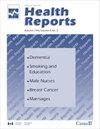了解加拿大儿童时期遭受非身体虐待的经历:自杀意念和心理健康障碍之间的关系是什么?
IF 3.3
2区 医学
Q2 PUBLIC, ENVIRONMENTAL & OCCUPATIONAL HEALTH
引用次数: 0
摘要
背景童年时期遭受的身体虐待和性虐待与自杀意念和心理健康障碍有关。然而,人们对非身体类型的虐待却知之甚少。本研究考察了非身体类型的儿童虐待(如情感虐待、人际攻击、亲密伴侣身体暴力暴露、情感和身体忽视)与自杀意念和心理健康障碍之间的关联。数据和方法使用2018年公共和私人空间安全调查的数据来估算加拿大15岁及以上在童年时期经历过非身体虐待的人的比例。结果总体而言,人际攻击最为常见(45.7%),其次是情感虐待(40.4%)和情感忽视(20.0%)。童年时期遭受过任何类型的非身体虐待的人,其终生产生自杀念头的概率要高于那些从未遭受过虐待的人。与从未经历过这些类型虐待的人相比,经历过情感虐待、人际攻击和情感忽视的人更有可能被诊断为情绪障碍。与从未经历过所调查的虐待的人相比,经历过情感虐待、人际攻击、情感忽视或身体忽视的人更有可能被诊断为焦虑症。经历过情感忽视和身体忽视的人比从未经历过这些类型虐待的人更有可能被诊断为创伤后应激障碍。研究结果强调了在基于人口的调查中纳入非身体类型的儿童虐待的重要性,以区分与心理健康结果的关联,从而更好地调整干预措施和政策。本文章由计算机程序翻译,如有差异,请以英文原文为准。
Understanding experiences of non-physical maltreatment in childhood in Canada: What is the relationship with suicidal ideation and mental health disorders?
Background
Physical and sexual childhood abuse are associated with suicidal ideation and mental health disorders. However, less is known about non-physical types of maltreatment. This study examined associations between non-physical types of child maltreatment (e.g., emotional abuse, interpersonal aggression, exposure to physical intimate partner violence, emotional and physical neglect) and suicidal ideation, and mental health disorders.
Data and methods
Data from the 2018 Survey of Safety in Public and Private Spaces were used to estimate the proportion of individuals 15 years and older in Canada who experienced non-physical maltreatment during childhood. Multivariable regression analyses were used to examine associations between five types of non-physical child maltreatment and suicidal ideation, and mental health disorders.
Results
Overall, interpersonal aggression was the most common (45.7%), followed by emotional abuse (40.4%) and emotional neglect (20.0%). Individuals who experienced any type of non-physical maltreatment in childhood had a higher probability of lifetime suicidal ideation than those who never experienced the maltreatment examined. Mood disorder diagnoses were more likely among those who experienced emotional abuse, interpersonal aggression, and emotional neglect than among those who never experienced these types of maltreatment. Compared with those who never experienced the maltreatment examined, individuals who experienced emotional abuse, interpersonal aggression, emotional neglect, or physical neglect were more likely to be diagnosed with an anxiety disorder. Diagnoses of post-traumatic stress disorder were more likely among those who experienced emotional and physical neglect than among those who never experienced these types of maltreatment.
Interpretation
Non-physical child maltreatment is associated with suicidal ideation and mental health disorders. The findings highlight the importance of including non-physical types of child maltreatment on population-based surveys to differentiate associations with mental health outcomes to better align interventions and policies.
求助全文
通过发布文献求助,成功后即可免费获取论文全文。
去求助
来源期刊

Health Reports
PUBLIC, ENVIRONMENTAL & OCCUPATIONAL HEALTH-
CiteScore
7.30
自引率
4.00%
发文量
28
期刊介绍:
Health Reports publishes original research on diverse topics related to understanding and improving the health of populations and the delivery of health care. We publish studies based on analyses of Canadian national/provincial representative surveys or Canadian national/provincial administrative databases, as well as results of international comparative health research. Health Reports encourages the sharing of methodological information among those engaged in the analysis of health surveys or administrative databases. Use of the most current data available is advised for all submissions.
 求助内容:
求助内容: 应助结果提醒方式:
应助结果提醒方式:


